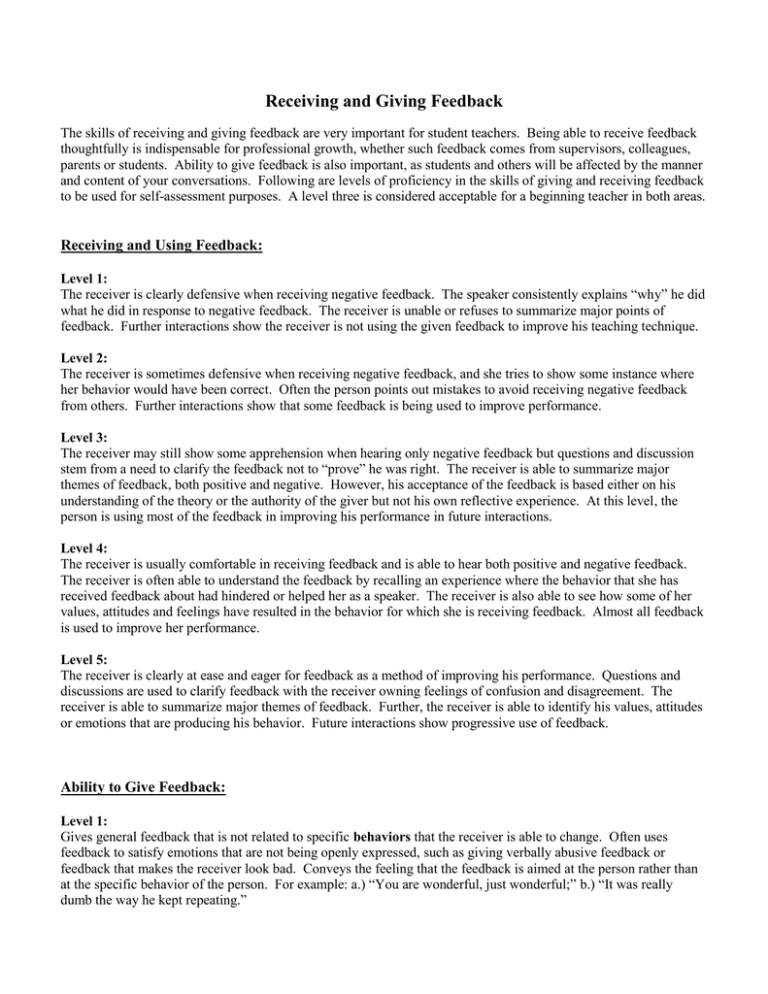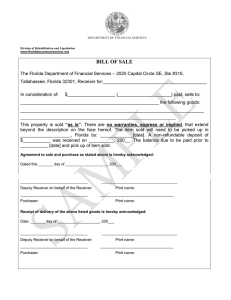Giving and Receiving Feedback
advertisement

Receiving and Giving Feedback The skills of receiving and giving feedback are very important for student teachers. Being able to receive feedback thoughtfully is indispensable for professional growth, whether such feedback comes from supervisors, colleagues, parents or students. Ability to give feedback is also important, as students and others will be affected by the manner and content of your conversations. Following are levels of proficiency in the skills of giving and receiving feedback to be used for self-assessment purposes. A level three is considered acceptable for a beginning teacher in both areas. Receiving and Using Feedback: Level 1: The receiver is clearly defensive when receiving negative feedback. The speaker consistently explains “why” he did what he did in response to negative feedback. The receiver is unable or refuses to summarize major points of feedback. Further interactions show the receiver is not using the given feedback to improve his teaching technique. Level 2: The receiver is sometimes defensive when receiving negative feedback, and she tries to show some instance where her behavior would have been correct. Often the person points out mistakes to avoid receiving negative feedback from others. Further interactions show that some feedback is being used to improve performance. Level 3: The receiver may still show some apprehension when hearing only negative feedback but questions and discussion stem from a need to clarify the feedback not to “prove” he was right. The receiver is able to summarize major themes of feedback, both positive and negative. However, his acceptance of the feedback is based either on his understanding of the theory or the authority of the giver but not his own reflective experience. At this level, the person is using most of the feedback in improving his performance in future interactions. Level 4: The receiver is usually comfortable in receiving feedback and is able to hear both positive and negative feedback. The receiver is often able to understand the feedback by recalling an experience where the behavior that she has received feedback about had hindered or helped her as a speaker. The receiver is also able to see how some of her values, attitudes and feelings have resulted in the behavior for which she is receiving feedback. Almost all feedback is used to improve her performance. Level 5: The receiver is clearly at ease and eager for feedback as a method of improving his performance. Questions and discussions are used to clarify feedback with the receiver owning feelings of confusion and disagreement. The receiver is able to summarize major themes of feedback. Further, the receiver is able to identify his values, attitudes or emotions that are producing his behavior. Future interactions show progressive use of feedback. Ability to Give Feedback: Level 1: Gives general feedback that is not related to specific behaviors that the receiver is able to change. Often uses feedback to satisfy emotions that are not being openly expressed, such as giving verbally abusive feedback or feedback that makes the receiver look bad. Conveys the feeling that the feedback is aimed at the person rather than at the specific behavior of the person. For example: a.) “You are wonderful, just wonderful;” b.) “It was really dumb the way he kept repeating.” Level 2: There is some general feedback expressed, but the person offering feedback also gives some specific behavioral feedback that the receiver could act upon. Some typical behavior at this level includes: a.) not speaking directly to the person receiving the feedback; b.) evaluator using feedback to show how clever he is; c.) giving only positive feedback when negative feedback is clearly appropriate. Level 3: Gives specific feedback about behaviors that the receiver might be expected to alter. Does not give general feedback. However, feedback is based on theory and does not particularly reflect the personality or learning style of the receiver. Clearly communicates that the feedback is about the person’s behavior, not who the person is as a person. Gives both positive and negative feedback, although there might still be a tendency to soften the impact of the negative feedback. Checks to make sure the feedback has been clearly communicated and understood. Level 4: Begins to include examples of possible changes in behavior. Sometimes the feedback is based on the personality or learning style of the receiver. Begins to determine the emotional impact of the feedback on the receiver. Level 5: Gives specific feedback about specific behavior that is directed to the personality or learning style of the receiver. Readily supplies helpful examples of possible change. Gives negative feedback in a non-threatening manner. Consistently checks to make sure that the feedback has been communicated and the nature of the emotional impact of the feedback understood. Giving feedback after observing student teachers: 1. Encourage reflection. Ask questions such as: a. What were the students doing while you were teaching? What did they learn? How do you know? b. Did your lesson accomplish what you wanted it to accomplish? c. Which conditions/circumstances helped you accomplish your goals? d. What were the strengths of the lesson? What would you change about it? e. Can you think of another way you might have taught this that would improve the learning process? f. Were any changes needed in organizing the materials or setting to make the learning process more effective? 2. Be specific. Refer back to particular parts of the lesson and give examples if possible. 3. Focus on the behavior, not the person. 4. Give both positive feedback and suggestions for change. Focus on feedback (professional, specific comment aimed at improving performance) when discussing a lesson rather than just giving compliments (general, person statements aimed at creating a feeling). 5. Assess the emotional impact of the feedback on the student teacher. 6. Assess the degree of congruence between the supervisor’s perception and the student teacher’s perception of the lesson. Receiving feedback: 1. 2. 3. 4. Relax. This is all part of the learning process. Try to listen carefully to what the person is saying. Focus on the lesson, not personal issues. Ask questions to clarify if you do not understand or agree with what the person is saying. Use the feedback to shape your further teaching.





